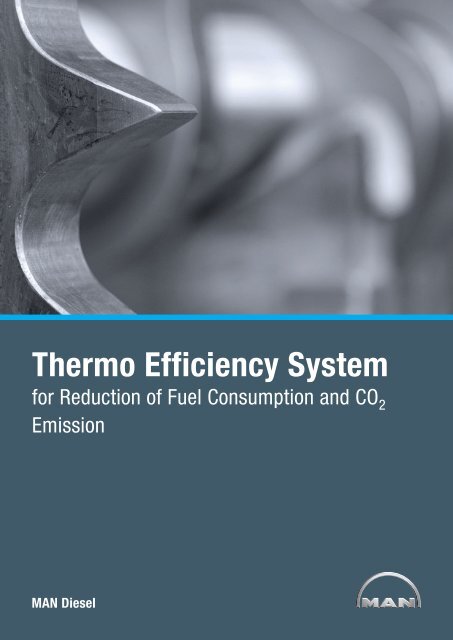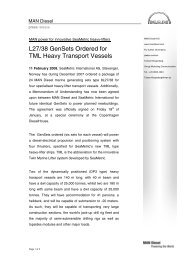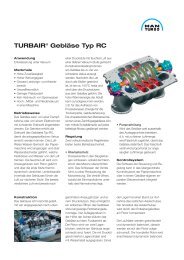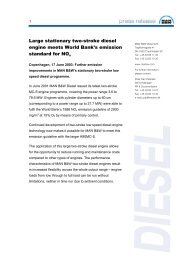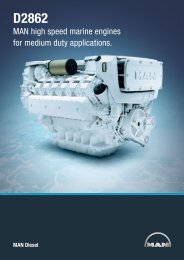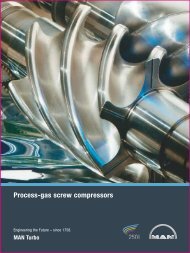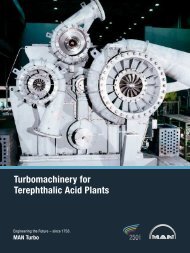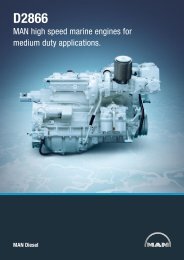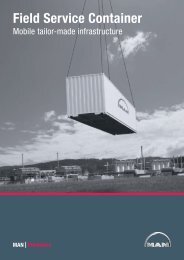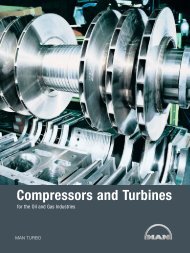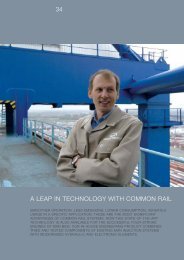Download file (1.8Mb) - MAN Diesel & Turbo SE
Download file (1.8Mb) - MAN Diesel & Turbo SE
Download file (1.8Mb) - MAN Diesel & Turbo SE
- No tags were found...
You also want an ePaper? Increase the reach of your titles
YUMPU automatically turns print PDFs into web optimized ePapers that Google loves.
ContentsIntroduction..................................................................................................5Description of the Thermo Efficiency System.................................................6Power concept and arrangement.............................................................6Main engine performance data......................................................................7Exhaust gas boiler and steam systems..........................................................8Obtainable Electric Power Production of the Thermo Efficiency System........ 10Exhaust gas turbine output.................................................................... 10Exhaust gas and steam turbine generator output – single pressure.............. 10Exhaust gas and steam turbine generator output – dual pressure................ 12Payback time of the Thermo Efficiency System............................................ 12Summary.................................................................................................... 15References................................................................................................. 15<strong>MAN</strong> B&W <strong>Diesel</strong>Termo Efficency System3
Thermo Efficiency System (TES)for Reduction of Fuel Consumption and CO 2 EmissionIntroductionFollowing the trend of required higheroverall ship efficiency since the first oilcrisis in 1973, the efficiency of the mainengines has increased and, today, thefuel energy efficiency is about 50%. Thishigh efficiency has, among others, ledto a correspondingly lower exhaust gastemperature after the turbochargers.Even though a main engine fuel energyefficiency of 50% is relatively high, theprimary objective for the shipowner isstill to lower the total fuel consumptionof the ship and, thereby, to reduce theCO 2 emission of his ship.Today an even lower CO 2 emission canbe achieved by installing a Thermo Efficiency System. However, the maindemand for installation of a Thermo Efficiency System is that the reliability andsafety of the main engine/ship operationmust not be jeopardised.As an example, the heat balance diagram for the nominally rated 12K98ME/MC engine (18.2 bar) of the standardhighefficiency version is shown in Fig.1a. Fig. 1b shows an example basedon the Thermo Efficiency System, validfor a singlepressure steam system,together with the corresponding figures for a dualpressure steam systemshown in parenthesis.The primary source of waste heat of amain engine is the exhaust gas heat dissipation, which accounts for about halfof the total waste heat, i.e. about 25%of the total fuel energy. In the standardhighefficiency engine version, the exhaust gas temperature after the turbocharger is relatively low, and just highenough for production of the necessarysteam for a ship’s heating purposes bymeans of the exhaust gas fired boiler.However, a main engine with changedtiming and exhaust gas bypass – whichredistributes the exhaust gas heat fromhigh amount/low temperature to lowamount/high temperature – increasesthe effect of utilising the exhaust gasheat, but at the same time may slightlyreduce the efficiency of the main engineitself. Such a system is called a ThermoEfficiency System (TES).Shaft poweroutput 49.3%12K98ME/MC Standard engine versionSMCR : 68,640 kW at 94.0 r/minISO ambient reference conditionsTotal power output 54.2% (54.8%)Shaft poweroutput 49.3%12K98ME/MC with TESSMCR : 68,640 kW at 94.0 r/minISO ambient reference conditionsTES : Single pressure (Dual pressure)El. power production ofTES 4.9% (5.5%)Gain = 9.9% (11.2%)Lubricating oilcooler 2.9%Jacket watercooler 5.2%Lubricating oilcooler 2.9%Jacket watercooler 5.2%Fuel 100%(171 g/kWh)Exhaust gas25.5%Air cooler16.5%Heat radiation0.6%Fuel 100%(171 g/kWh)Exhaust gas andcondenser22.9% (22.3%)Air cooler14.2%Heat radiation0.6%Fig. 1a: Heat balance diagram of the nominally rated 12K98ME/MC Mk 6engine (18.2 bar) of the standard engine version operating at ISO ambientreference conditions and at 100% SMCR<strong>MAN</strong> B&W <strong>Diesel</strong>Fig. 1b: Heat balance diagram of the nominally rated 12K98ME/MC Mk 6 engine(18.2 bar) with Thermo Efficiency System (TES) operating at ISO ambientreference conditions and at 100% SMCRTermo Efficency System5
Description of the Thermo EfficiencySystemPower concept and arrangementThe Thermo Efficiency System (TES)consists of an exhaust gas fired boilersystem, a steam turbine (often called aturbo generator), an exhaust gas turbine (often called a power turbine) anda common generator for electric powerproduction. The turbines and the generator are placed on a common bedplate.The system is shown schematically inFig. 2a, and the arrangement of thecomplete turbine generating set as proposed by Peter Brotherhood is shownin Fig. 2b.The exhaust gas turbine is driven by apart of the exhaust gas flow, which bypasses the turbochargers. The exhaustgas turbine produces extra output power for electric power production, whichdepends on the bypassed exhaust gasflow amount.When a part of the exhaust gas flow isbypassed the turbocharger, the totalamount of air and gas will be reduced,and the exhaust gas temperature afterthe turbocharger and bypass will increase. This will increase the obtainablesteam production from the exhaust gasfired boiler.The exhaust gas bypass valve will beclosed for engine loads lower than about50% SMCR, which means that the exhaust gas temperature will be reducedwhen operating below 50% SMCR.The power output from the exhaustgas turbine is transmitted to the steamturbine via a reduction gear (see Figs.2a and 2b) with an overspeed clutch,which is needed in order to protect theexhaust gas turbine from overspeedingin case the generator drops out.The total electric power output of theTES – which reduces the ship’s fuel costs– is only a gain provided that it can replace the power output of other electricpower producers on board the ship.Otherwise, a shaft power motor connected to the main engine shaft couldbe an option, as also shown in Fig. 2a,but this extra system is rather expensive.In general (without a shaft power motor installed), when producing too muchelectric power, the (high pressure) superheated steam to the steam turbineis controlled by a speed control governor through a single throttle valve,which means that the surplus steamis dumped via a dumping condenser.When the generator is operating in parallel with the auxiliary diesel generators,the governor operates in the normalway to give correct load sharing.Exh. gas boilerGenerator,AC alternatorReductiongearboxSteamturbineReduction gearwith overspeedclutchEmergencygeneratorSteam forheatingservicesLPSuperheatedsteamHPHPLPExh. gasturbineSwitchboard<strong>Diesel</strong> generators<strong>Turbo</strong>chargersShaft motor/generatorExhaust gas receiverMain engineFig. 2a: Power concept for the Thermo Efficiency System6 Termo Efficency System
Reduction gear withoverspeed clutchExh. gasturbineSteam turbineReductiongearboxGenerator,AC alternatorApprox. dimensionsreferring to a 12K98ME/MC:Length:10 metresBreadth: 3.5 metresWeight:58 tons withoutcondenserWeight:75 tons withcondenserFig. 2b: Arrangement of the complete turbine generating set as proposed by Peter Brotherhood LtdMain engine performance dataThe exhaust gas bypass and turbineare available with the following approx. effects, compared with a standard highefficiency main engine versionwithout an exhaust gas bypass:The mixed exhaust gas temperature before the exhaust gas boiler, and valid forthe TES and based on ISO ambient reference conditions, is shown as a function of the engine load in Fig. 3. Whenoperating under higher ambient air temperatures, the exhaust gas temperaturewill be higher (about +1.6°C per +1°Cair), and vice versa for lower ambient airtemperatures.ParametersPower outputof exhaust gasturbine at 100%SMCR, up toReduction of total exhaust gasamount, approx. -13%Total increase ofmixed exhaust gastemperature afterbypass, up toIncreased fuelconsumptionOpen exhaust gasbypass for exhaustgas turbine+4.6% SMCRpower+50°Cfrom 0.0% to+1.8%<strong>MAN</strong> B&W <strong>Diesel</strong>Exhaust gas temperatureafter exh. gas bypass°C35030025020040 50 60 70 80 90 100 % SMCRExh. gas bypassMainengine shaft powerclosedopenAmbient reference conditions:Tropical 45°C air/36°C c.w.ISO 25°C air/25°C c.w.Winter 15°C air/36°C c.w.Fig. 3: Exhaust gas temperature after exhaust gas bypass for a main engine with TESTropicalISOWinterTermo Efficency System7
Exh. gas boilersections:PreheaterEvaporatorSuperheaterCirc. pumpSteamdrumThe increased fuel consumption of themain engine depends on the actualmaximum firing pressure (Pmax) used.The Pmax used for TES will normally beincreased – compared with a standardengine – and thereby an increase of thespecific fuel oil consumption can beavoided when using TES.Exhaust gasSurplusvalveCondenserSteamturbineSat. steamfor heatingservicesHot wellFeedwaterpumpFig. 4: Process diagram for the Thermo Efficiency System – singlepressure exhaust gas boiler systemwith a singlepressure steam turbineTemperature°C300Superheatedsteam 250Exh. gasExh. gas boiler sections:A. SuperheaterB. EvaporatorC. PreheaterThe exhaust gas boiler and steam turbine systems analysed in this paper arebased on the two types below:1. Single-pressure steam systemThe simple singlepressure steamsystem is only utilising the exhaustgas heat. See the process diagramin Fig. 4 and the corresponding temperature/heat transmission diagramin Fig. 5. The steam drum from theoil fired boiler can also be used instead of a separate steam drum.200Saturatedsteam150Steam/water min 20 °C7 bar abs/165 °CExh. gas100ABC500Ambient air04 20 0 60 80 100%Heat transmissionExhaust gas boiler and steam systemsFeedwaterFig. 5: Temperature/heat transmission diagram of an exhaust gas boiler with singlepressure´steamsystem valid for a main engine with TES and operating at 85% SMCR/ISO8 Termo Efficency System
2. Dualpressure steam systemWhen using the dualpressure steamsystem, it is not possible to install anexhaust gas lowpressure preheatersection in the exhaust gas boiler, because the exhaust gas boiler outlettemperature otherwise would be toolow and increase the risk of wet (oily)soot deposits on the boiler tubes.The more complex dualpressuresteam system, therefore, needssupplementary waste heat recovery(WHR) sources (jacket water andscavenge air heat) for preheating ofthe feedwater which, of course, willincrease the obtainable steam andelectric power production of TES.See the process diagram in Fig. 6and the corresponding temperature/heat transmission diagram in Fig. 7.Exh. gas boilersections:LP-EvaporatorHP-PreheaterLP-SuperheaterHP-EvaporatorHP-SuperheaterExhaustgasSurplusvalveHPCondenserLPSteamturbineAlternative WHRsources for feedwaterpreheatingLPLP-circ. pumpHPHP-circ. pumpHP-steamfor heatingservicesLP-steam drumHP-steam drumFeedwaterpumpIf no alternative waste heat recovery sources are used to preheat thefeedwater, the low pressure (LP)steam may be used to preheat thefeedwater, involving an about 16%reduction of the total steam production.The available superheated steam usedfor the steam turbine is equal to thesurplus steam after deduction of thesaturated steam needed for heatingservices.The exhaust gas boiler has to be designed in such a way that the risk ofsoot deposits and fires is minimised,Ref. [1].Fig. 6: Process diagram for the Thermo Efficiency System – dualpressure exhaust gas boiler systemwith a dualpressure steam turbineSuperheatedHP steamSaturatedHP steamTemperature°C30025020015010050Exh. gasSteam/water min 20°C10 bar abs/180°CHot wellA BC D EExh. gas boiler sections:A. HP-superheaterB. HP-evaporatorC. HP-preheaterD. Possible LP-superheaterE. LP-evaporatorSuperheated LP steammin 15°C4 bar abs/144°CAmbient air004 20 0 60 80 100%Heat transmissionExh. gasFeedwaterpreheatedby alternativeWHR sourcesFig. 7: Temperature/heat transmission diagram of an exhaust gas boiler with dualpressure steam system<strong>MAN</strong> B&W <strong>Diesel</strong>valid for a main engine with TES and operating at 85% SMCR/ISOTermo Efficency System9
Obtainable Electric Power Productionof the Thermo Efficiency SystemExhaust gas turbine outputThe exhaust gas bypass for the exhaust gas turbine has a bypass gasamount of approx. 12% of the total exhaust gas amount at 100% SMCR. Thisbypassgas amount led through theexhaust gas turbine will typically produce an available power output of max.4.6% of the SMCR power when runningat 100% SMCR. The correspondingelectric power output will be somewhatlower because of generator and gearlosses.At part load running of the main engine,the power output will be reduced by approximately the square root of the engine load.As an example, the maximum availablepower output of the exhaust gas turbinevalid for a nominally rated 12K98ME/MC (18.2 bar) engine is shown in Fig. 8,as a function of the engine load.Exhaust gas and steam turbine generatoroutput – single pressureThe singlepressure steam system is asystem where all heat recovered comesfrom the exhaust gas heat only, whichmakes it relatively simple, see Figs. 4and 5.As low gas temperatures (risk of condensed sulphuric acid) and low gas velocities (risk of soot deposits) throughthe exhaust gas boiler may have a deteriorating effect on the boiler, Ref. [1], wehave, in our studies, selected an exhaustgas boiler designed for a singlepressuresteam system of minimum 7 bar abs(6 bar g) steam pressure (165°C),and minimum 20°C pinch point. Thesuperheated steam temperature isabout 270°C. The steam turbine is amultistage singlepressure condensingtype. The alternator/generator is drivenboth by the steam turbine and the exhaust gas turbine.As an example valid for the nominallyrated 12K98ME/MC (18.2 bar) engineoperating at ISO ambient reference conditions, we have calculated the steamproduction and the electric power production of TES, see Figs. 10 and 11.The total electric power production in %of the main engine shaft power output isalso shown as a function of the engineload, see Fig. 9.The results for operation at 85% SMCRare shown in Fig. 14, together with thecalculated ISO ambient temperaturebased results for three other main engine types. The corresponding resultsbased on tropical ambient temperatureconditions are shown in Fig. 15. However, it should be emphasised that it isprobably more realistic to use the ISOambient temperatures as the averageambient temperatures in worldwide operation. In Fig. 16, the ISO based totalelectric power production at 85% SMCRis also shown as a function of the mainengine size measured in SMCR power.Available power output of exhaust gas turbinekW3,5003,0002,5002,0001,5001,000500030 40 50 60 70Exh. gas bypassclosed openExhaustgas turbine80 90 100 % SMCRMain engine shaf t powerFig. 8: Expected available power output of exhaust gas turbine for a12K98ME/MC with SMCR = 68,640 kW x 94 r/minElectric power production of TESrelative to the main engine power output%13 Main engine 12K98ME/MC12 SMCR = 68,640 kW at 94 r/min1110987654321ISO amb. cond.Steam turbineExhaustgas turbineDual press.Single press.050 60 70 80 90 100 % SMCRMain engine shaft powerFig. 9: Expected electric power production in % of the main engine shaft poweroutput valid for a 12K98ME/MC with Thermo Efficiency System (TES) andbased on ISO ambient reference conditions10 Termo Efficency System
Obtainable steam productionkg/h35,000Electric power productionkW8,00030,00025,00012K98ME/MC with TES (single press.)SMCR = 68,640 kW at 94 r/minISO amb. cond.Total steampr oduction7,0006,00012K98ME/MC with TES (single press.)SMCR = 68,640 kW at 94 r/minISO amb. cond.Total el.production20,0005,00015,00010,000Superheated steamfor steam turbine4,0003,000Exhaustgas turbine5,000040 50 60 70 80 90 100 % SMCRExh. gas bypassMain engine shaft powerclosed open2,0001,000040 50 60 70Exh. gas bypassclosed openSteam turbine80 90 100 % SMCRMain engine shaft powerFig. 10: Expected steam production of an exhaust gas boiler withsinglepressure steam system valid for main engine 12K98ME/MC with TESand based on ISO ambient reference conditionsFig. 11: Expected electric power production of the Thermo Efficiency System(TES) with a singlepressure steam system valid for main engine 12K98ME/MC and based on ISO ambient reference conditionsObtainable steam productionkg/h40,00012K98ME/MC with TES (dual press.)35,000 SMCR = 68,640 kW at 94 r/minISO amb. cond.30,00025,000SuperheatedLP-steam forsteam turbineTotal steamproductionElectric power productionkW8,0007,0006,0005,00012K98ME/MC with TES (dual press.)SMCR = 68,640 kW at 94 r/minISO amb. cond.Total el.production20,0004,000Exhaustgas turbine15,0003,00010,0005,000Superheatedfor steam turbine2,0001,000Steam turbine040 50 60 70 80 90 100 % SMCRExh. gas bypassMain engine shaft powerclosed open040 50 60 70 80 90 100 % SMCRExh. gas bypassMain engine shaft powerclosed openFig. 12: Expected steam production of an exhaust gas boiler with adualpressure steam system valid for main engine 12K98ME/MC with TES andbased on ISO ambient reference conditions<strong>MAN</strong> B&W <strong>Diesel</strong>Fig. 11Expected steam production of an exhaust gas boiler with a dual-pressuresteam system valid for main engine 12K98ME/MC with TES and basedon ISO ambient reference conditionsFig. 13: Expected electric power production of the Thermo Efficiency System(TES) with a dualpressure steam system valid for main engine 12K98ME/MCand based on ISO ambient reference conditionsTermo Efficency System 11
Exhaust gas and steam turbine generatoroutput – dual pressureBesides the singlepressure steam system,a more complex and more expensivedualpressure steam system is alsoavailable, see Figs. 6 and 7. The highand low steam pressures used areabout 1011 and 45 bar abs (910 and34 bar g), respectively.The steam turbine is a multistage dualpressure condensing type. The alternator/generator is driven both by the steamturbine and the exhaust gas turbine.Because of the low steam pressure andcorresponding low saturated steam temperature (144°C/4.0 bar abs), there is noroom for an LPpreheater section in theexhaust gas boiler for feedwater preheating, because the exhaust gas boileroutlet temperature has to be higher thanabout 160165°C in order to avoid sulphuric acid corrosion of the boiler outlet.The feedwater, therefore, has to bepreheated by means of alternative heatsources such as the jacket water andscavenge air cooler heat.Furthermore, the pinch point shouldnot be too low (giving low gas velocities through the boiler) in order to protect the exhaust gas boiler against sootdeposits and fires.As an example valid for the nominallyrated 12K98ME/MC (18.2 bar) engine operating at ISO ambient reference conditions, we have calculatedthe steam production and the electric power production of the TES, seeFigs. 12 and 13.The total electric power production in %of the main engine shaft power output isalso shown as a function of the engineload, see Fig. 9.The results for operation at 85% SMCRare shown in Fig. 14, together with thecalculated ISO ambient temperaturebased results for three other main engine types. The corresponding resultsbased on tropical ambient temperatureconditions are shown in Fig. 15. However, it should be emphasised that it isprobably more realistic to use the ISOambient temperatures as the averageambient temperatures in worldwide operation. In Fig. 16, the ISO based totalelectric power production at 85% SMCRis also shown as a function of the mainengine size measured in SMCR power.Payback time of the ThermoEfficiency SystemThe payback time of TES depends verymuch on the size of the main engineand the trade pattern (main engine loadand ambient temperatures) of the ship.Main engines operating at 85% SMCR and ISO ambient reference conditionsME = Main engineEGT = Exh. gas turbineST1 = Steam turbineSingle steam pressure7.0 bar absST2 = Steam turbineDual steam pressure4.0 bar abs/10.0 bar absAdditional feed waterpreheating requiredTES1 = EGT+ST1TES2 = EGT+ST2In normal service at85% SMCR per year:280 daysShip type VLCC 4,500 teu 6,000 teu 8,000 teuMain engine type 6S90ME-C 7K98ME-C 12K90ME 12K98MESpecified MCR (L1) kW 29,340 39,970 54,840 68,640Main engine load % SMCR 85 85 85 85Main engine power output kW 24,939 33,975 46,614 58,344Steam consumption for heating services kg/h 1,400 1,800 2,400 3,000EGT electric power production, approx. kW 920 1,260 1,730 2,180in % of ME output % 3.7 3.7 3.7 3.7ST1 electric power production kW 1,110 1,640 2,250 2,840in % of ME output % 4.5 4.8 4.8 4.9ST2 electric power production kW 1,360 2,020 2,800 3,520in % of ME output % 5.4 5.9 6.0 6.0Total TES1 electric power production kW 2,030 2,900 3,980 5,020in % of ME output % 8.2 8.5 8.5 8.6Annual fuel savings USD/year 374,000 528,000 724,000 917,000payback time year 8.8 7.0 5.8 5.0Total TES2 electric power production kW 2,280 3,280 4,530 5,700in % of ME output % 9.1 9.6 9.7 9.8Annual fuel savings USD/year 415,000 596,000 818,000 1,045,000Payback time year 8.8 7.0 5.8 5.0Fig. 14: Steam and electric power production and payback time of the Thermo Efficiency System (TES) when operating at 85% SMCR and ISO ambientreference conditions12 Termo Efficency System
Main engines operating at 85% SMCR and tropical ambient conditionsME = Main engineEGT = Exh. gas turbineST1 = Steam turbineSingle steam pressure7.0 bar absST2 = Steam turbineDual steam pressure4.0 bar abs/10.0 bar absAdditional feed waterpreheating requiredTES1 = EGT+ST1TES2 = EGT+ST2Ship type VLCC 4,500 teu 6,000 teu 8,000 teuMain engine type 6S90ME-C 7K98ME-C 12K90ME 12K98MESpecified MCR (L 1) kW 29,340 39,970 54,840 68,640Main engine load % SMCR 85 85 85 85Main engine power output kW 24,939 33,975 46,614 58,344Steam consumption for heating services kg/h 900 1,200 1,600 2,000EGT electric power production, approx. kW 880 1,200 1,650 2,070in % of ME output % 3.5 3.5 3.5 3.5ST1 electric power production kW 1,600 2,300 3,150 4,000in % of ME output % 6.4 6.8 6.8 6.9ST2 electric power production kW 1,950 2,800 3,830 4,850in % of ME output % 7.8 8.2 8.2 8.3Total TES1 electric power production kW 2,480 3,500 4,800 6,070in % of ME output % 9.9 10.3 10.3 10.4Total TES2 electric power production kW 2,830 4,000 5,480 6,920in % of ME output % 11.3 11.8 11.8 11.9Fig. 15: Steam and electric power production of the Thermo Efficiency System (TES) when operating at 85% SMCR and tropical ambient conditionsWhen for example operating at tropicalambient conditions, the electric poweroutput of the TES is higher than for ISOambient conditions, which again has ahigher TES output compared with winter ambient conditions.Based on the average operation in service at 85% SMCR = 58,344 kW in 280days a year, SFOC = 0.00017 t/kWhand a fuel price of 160 USD/t the annualmain engine fuel costs of the standard12K98ME/MC engine are as follows:Furthermore, the investment costs perinstalled kWe output of a TES plant arerelatively cheaper the bigger the plant is.A simple estimation of the average savedfuel costs in service at ISO ambient temperature conditions for a 12K98ME/MCwith TES (for single or dual pressure)compared to a standard 12K98ME/MCengine can be found by means of thealready estimated relative TES1/TES2gain of 8.6%/9.8% of the main engineoutput, see Fig. 14.Possible annual savings of fuel costsmill. USD/yearkW Electric power production7,0001.2Normal service : 85% SMCR in 280 days/yearFuel consumption : 0.17 kg/kWh6,000 Fuel price : 160 USD/t1.00.80.60.40.25,0004,0003,0002,0001,000ISO ambient reference conditionsSteam turbineExhaust gas turbineDual press.Single press.0020,000 40,00060,000 80,000 kWSize of main engine, SMCR powerFig. 16: Expected total electric power production and possible annual fuel cost savings of the Thermo<strong>MAN</strong> B&W <strong>Diesel</strong>Efficiency System (TES) based on ISO ambient reference conditions and 85% SMCR, shown as afunction of the main engine size, SMCR powerTermo Efficency System13
Fuel costs = 280 days/y x 24 h/dayx 0.00017 t/kWhx 58,344 kWx 160 USD/t= 10,664,000 USD/yearFor the single and dualpressure systems, respectively, the TES gain insaved fuel consumptions will then be asfollows:TES1 savings = 0.086 x 10,664,000= 917,000 USD/yearTES2 savings = 0.098 x 10,664,000= 1,045,000 USD/yearas shown in Fig. 14.The similar fuel cost savings valid for theother three cases with smaller main engines are also stated in Fig. 14, and incurve form in Fig. 16 as a function of themain engine size, SMCR power.Based on the extra investment costs ofthe TES plant (without installation of ashaft power motor on the main engineshaft and minus the investment cost ofa normal exhaust gas boiler system) forthe four main engine cases comparedto a standard main engine installation,the estimated payback time found isas stated in Fig. 14, i.e. in principle thesame for the single and dualpressuresystems. For the 12K98ME/MC engine,the calculated payback time is aboutfive years.In Fig. 17, the estimated payback timeof the TES plant is shown as a functionof the main engine size. The paybacktime is only valid provided all electricpower production savings are used onboard the ship.It has been assumed that the increasedspecific fuel consumption of the TESmain engine has been avoided by usingan increased firing pressure, Pmax.Fig. 17: Estimated payback time of the Thermo Efficiency System (TES) valid for both a single and adualpressure steam systemPayback time of TESYear1312Normal service : 85% SMCRIn service per year : 280 days/year11109Fuel consumption : 0.17 kg/kWhFuel price : 160 USD/tISO ambient reference conditions87654321020,000 40,000 60,000 80,000 kWSize of main engine, SMCR power14 Termo Efficency System
SummaryOur calculations indicate that for ISOambient reference conditions, a reduction of the fuel consumption of 810%for a singlepressure system is possiblein the normal service range of the mainengine. The larger the engine load, thegreater the possible reduction.For the more complex dualpressuresystem, the corresponding reduction isabout 911%.dualpressure systems, because theincreased electric power productiongain of the dualpressure system mightcorrespond to about the same relativeincrease of the investment costs compared to the singlepressure system.When selecting the type of Thermo Efficiency System, the correspondinglyinvolved higher risks for soot depositsand fires of the exhaust gas boiler hasto be considered, see Ref. [1].References[1] Soot Deposits and Fires in Exhaust Gas Boilers, <strong>MAN</strong> B&W <strong>Diesel</strong> A/S, Copenhagen, Denmark,p.280,March 2004.All calculations presume unchangedMTBOs (maintenance time betweenoverhauls) compared to today’s expectations.However, if the ship sails frequently incold weather conditions, the electricpower production of the steam turbinewill be reduced, and the abovestatedreduction of fuel consumption and corresponding reduction of CO 2 emissionmight not be met.Because of this, but also because ofthe more simple singlepressure steamboiler system, <strong>MAN</strong> B&W <strong>Diesel</strong> recommends using the singlepressure steamsystem, when installing TES.Of course, the more complex and moreexpensive dualpressure steam system,which gives a somewhat higher electric power output, may also be used inconnection with <strong>MAN</strong> B&W twostrokemain engine types.The extra investment costs of the ThermoEfficiency System and the paybackof the investment can be obtained bymeans of lower fuel/lube oil costs and,not to forget, the possibility of obtainingadditional freight charters and higherfreight rates, thanks to the ‘green ship’image!The payback time calculations basedon a large container vessel with a12K98ME/MC as main engine and asaverage operating at 85% SMCR andat ISO ambient reference conditions innormal service during 280 days/yearindicate a payback time of about 5 yearsfor the TES. The payback time is validfor both the singlepressure and the<strong>MAN</strong> B&W <strong>Diesel</strong>The TES is rather expensive, and relativelymore expensive the smaller the mainengine and the TES are, giving a relatively higher payback time. Therefore,the installation of the TES is normallyonly relevant for the large merchant ships,such as the large container vessels.The TES may be delivered as a package by Peter Brotherhood (turbines)in cooperation with Aalborg Industries(boiler) and Siemens (generator) or byother makers.Termo Efficency System15
Copyright © <strong>MAN</strong> <strong>Diesel</strong> · Subject to modification in the interest of technical progress. · 5510-0030-01ppr Aug09 Printed in Denmark<strong>MAN</strong> <strong>Diesel</strong>Teglholmsgade 41, 2450Copenhagen, DenmarkPhone +45 33 85 11 00Fax +45 33 85 10 30mandiesel-cph@mandiesel.comwww.mandiesel.com


